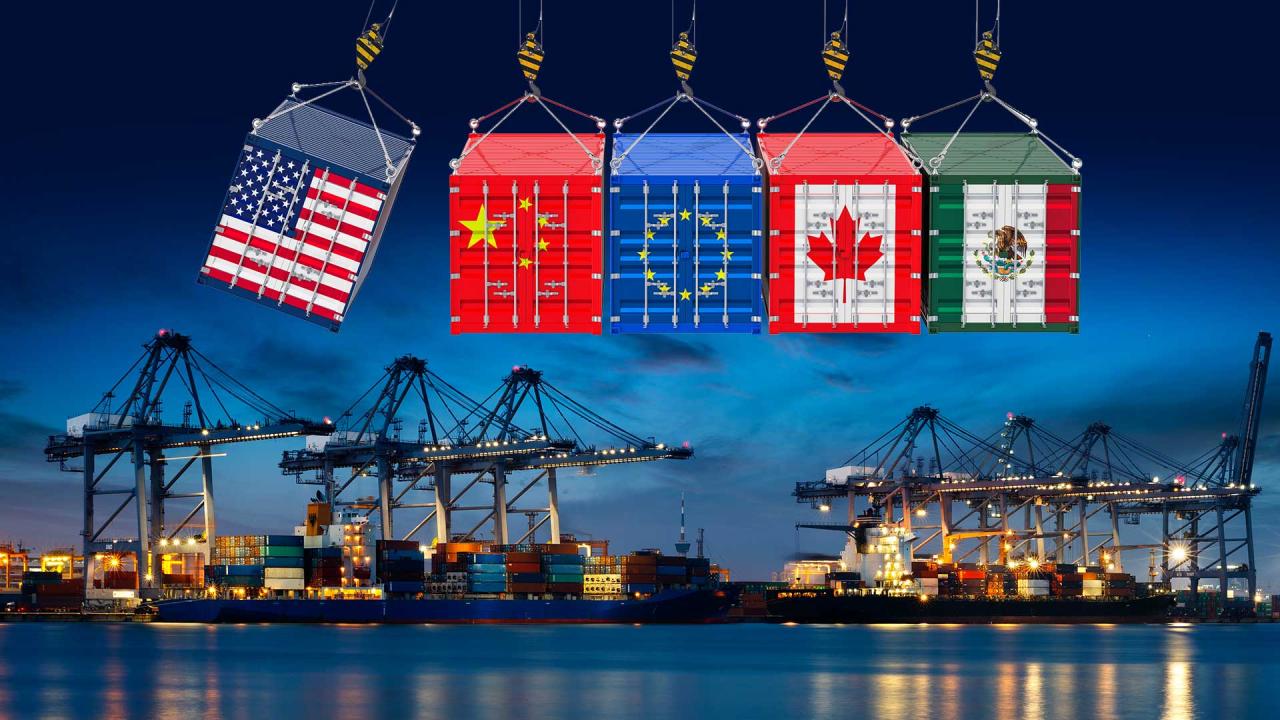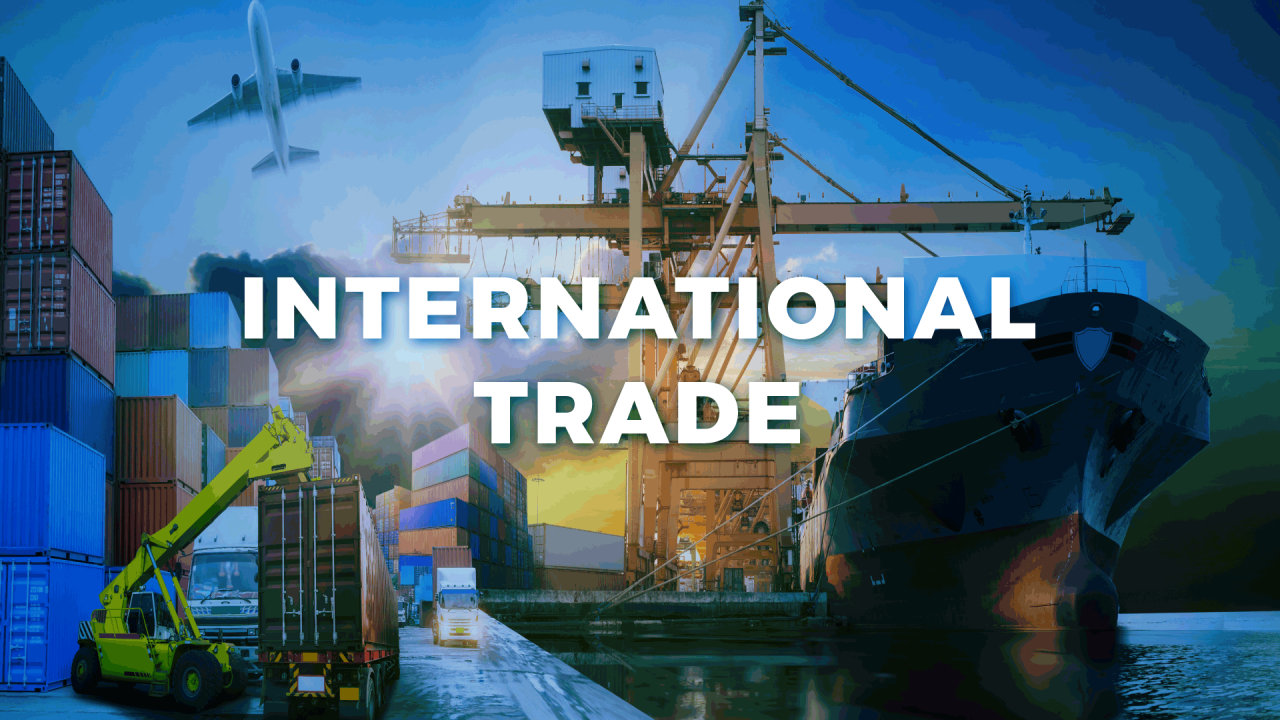Impact of Tariffs on Trade

Business News on Trade and Tariffs – Tariffs, a form of trade barrier, have played a significant role in shaping international trade throughout history. They are government-imposed taxes or duties levied on imported goods, aimed at protecting domestic industries or generating revenue.
Types of Tariffs
There are various types of tariffs, each with its unique impact on trade flows:
- Ad Valorem Tariffs:Calculated as a percentage of the value of the imported goods, these tariffs increase with the value of the goods.
- Specific Tariffs:A fixed amount of tax imposed per unit of imported goods, regardless of their value.
- Compound Tariffs:A combination of ad valorem and specific tariffs, providing a higher level of protection.
- Protective Tariffs:Designed to shield domestic industries from foreign competition by making imported goods more expensive.
- Revenue Tariffs:Primarily intended to generate revenue for the government rather than protect domestic industries.
Impact on Trade Flows
Tariffs can have a profound impact on the flow of goods and services across borders:
- Reduced Imports:Tariffs make imported goods more expensive, discouraging consumers from purchasing them, leading to a decline in imports.
- Increased Domestic Production:By protecting domestic industries from foreign competition, tariffs encourage domestic production, potentially leading to job creation.
- Consumer Price Increases:Tariffs can result in higher prices for consumers as the increased cost of imported goods is passed on to them.
- Trade Wars:Retaliatory tariffs imposed by countries in response to each other’s tariffs can escalate into trade wars, disrupting global trade and harming economies.
Examples of Affected Industries
Tariffs have impacted various industries and sectors throughout history:
- Steel Industry:Protective tariffs have been used to protect domestic steel industries, leading to increased production and employment.
- Agricultural Products:Tariffs on agricultural products, such as sugar and wheat, have been implemented to support farmers and maintain food security.
- Automobile Industry:Tariffs on imported cars have been used to protect domestic automobile manufacturers and promote local production.
Economic Implications of Trade Barriers

Trade barriers, such as tariffs, quotas, and embargoes, can have significant economic consequences for both consumers and producers. These measures are often implemented with the intention of protecting domestic industries or achieving specific economic goals, but they can also lead to unintended consequences and inefficiencies.
Impact on Consumer Prices
Tariffs, which are taxes imposed on imported goods, directly increase the cost of those goods for consumers. This can lead to higher prices for a wide range of products, from clothing and electronics to food and beverages. In some cases, consumers may choose to purchase cheaper domestic alternatives or reduce their consumption of imported goods, leading to a decline in demand for foreign products.
Impact on Producer Profits
Trade barriers can also affect the profits of producers. Tariffs and quotas can make it more expensive for domestic producers to import raw materials or intermediate goods, which can reduce their profit margins. On the other hand, trade barriers can protect domestic producers from foreign competition, allowing them to charge higher prices and increase their profits.
Impact on Overall Economic Growth, Business News on Trade and Tariffs
The overall impact of trade barriers on economic growth is complex and depends on a variety of factors, including the specific type of barrier, the industry affected, and the broader economic context. In some cases, trade barriers can lead to a decline in economic growth by reducing trade volumes, discouraging investment, and increasing costs for businesses.
However, in certain circumstances, trade barriers can also stimulate economic growth by protecting infant industries or promoting domestic production.
Winners and Losers
The implementation of trade barriers can create both winners and losers. Consumers who rely on imported goods may face higher prices, while domestic producers who compete with foreign imports may benefit from increased protection. The overall impact on economic growth and welfare depends on the balance of these effects.
Political and Diplomatic Aspects of Trade Negotiations
Trade negotiations involve complex political and diplomatic strategies. Governments and international organizations play crucial roles in shaping trade policies and agreements.Governments represent the interests of their countries and industries. They negotiate with other countries to secure favorable trade terms, such as lower tariffs or increased market access.
International organizations, like the World Trade Organization (WTO), provide a platform for multilateral trade negotiations and enforce trade rules.
Political Strategies
Political strategies in trade negotiations include:
- Coalitions and Alliances:Countries may form coalitions or alliances with similar trade interests to strengthen their negotiating position.
- Threat of Retaliation:Countries may threaten to impose tariffs or other trade barriers on countries that do not cooperate.
- Trade Sanctions:Governments may impose trade sanctions, such as embargoes or boycotts, to pressure other countries into compliance.
Diplomatic Strategies
Diplomatic strategies involve using diplomacy and negotiation to resolve trade disputes and reach agreements. These strategies include:
- Bilateral Negotiations:Direct negotiations between two countries to resolve specific trade issues.
- Multilateral Negotiations:Negotiations involving multiple countries under the auspices of international organizations like the WTO.
- Mediation and Arbitration:Third parties may facilitate negotiations or arbitrate disputes between countries.
Impact on International Relations
Trade disputes and trade wars can have significant impacts on international relations. They can lead to:
- Political Tensions:Trade disputes can escalate into political tensions and diplomatic crises.
- Economic Instability:Trade wars can disrupt global supply chains and harm economies.
- Damage to Cooperation:Trade disputes can undermine international cooperation on other issues.
Current Events and Case Studies: Business News On Trade And Tariffs
In a globalized economy, trade negotiations and tariff disputes are constantly shaping the business landscape. Understanding these events and their impact on businesses is crucial for effective decision-making and strategic planning.
Case studies provide valuable insights into the challenges and opportunities businesses face in navigating trade barriers. They showcase both successful and unsuccessful implementations of trade policies, highlighting best practices and lessons learned.
Impact of US-China Trade War
- The ongoing trade war between the US and China has had a significant impact on global trade and economic growth.
- Tariffs imposed on billions of dollars worth of goods have disrupted supply chains, increased costs, and reduced market access for businesses.
- The dispute has also heightened geopolitical tensions and raised concerns about the future of the global trading system.
Success of the EU Single Market
The European Union’s Single Market is often cited as a successful example of trade liberalization.
- By eliminating barriers to trade within the EU, the Single Market has created a seamless economic zone with increased competition, innovation, and economic growth.
- It has also facilitated the free movement of goods, services, capital, and labor, leading to increased investment and job creation.
Challenges for Businesses in a Globalized Economy
In a globalized economy, businesses face both challenges and opportunities as they navigate trade barriers.
- Tariffs and other trade barriers can increase costs, reduce market access, and disrupt supply chains.
- Businesses must adapt to changing regulatory landscapes and geopolitical tensions that can impact their operations.
- However, globalization also presents opportunities for businesses to expand their reach, access new markets, and collaborate with international partners.